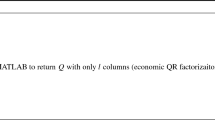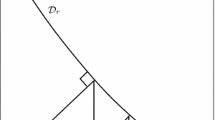Abstract
We provide a comparative study of the Subspace Projected Approximate Matrix method, abbreviated SPAM, which is a fairly recent iterative method of computing a few eigenvalues of a Hermitian matrix A. It falls in the category of inner-outer iteration methods and aims to reduce the costs of matrix-vector products with A within its inner iteration. This is done by choosing an approximation A 0 of A, and then, based on both A and A 0, to define a sequence (A k ) n k=0 of matrices that increasingly better approximate A as the process progresses. Then the matrix A k is used in the kth inner iteration instead of A.
In spite of its main idea being refreshingly new and interesting, SPAM has not yet been studied in detail by the numerical linear algebra community. We would like to change this by explaining the method, and to show that for certain special choices for A 0, SPAM turns out to be mathematically equivalent to known eigenvalue methods. More sophisticated approximations A 0 turn SPAM into a boosted version of Lanczos, whereas it can also be interpreted as an attempt to enhance a certain instance of the preconditioned Jacobi-Davidson method.
Numerical experiments are performed that are specifically tailored to illustrate certain aspects of SPAM and its variations. For experiments that test the practical performance of SPAM in comparison with other methods, we refer to other sources. The main conclusion is that SPAM provides a natural transition between the Lanczos method and one-step preconditioned Jacobi-Davidson.
Similar content being viewed by others
References
Z. Bai, J. Demmel, J. Dongarra, A. Ruhe, H. van der Vorst (eds.): Templates for the Solution of Algebraic Eigenvalue Problems: A Practical Guide. Software-Environments-Tools. 11, SIAM, Philadelphia, 2000.
F. L. Bauer, C. T. Fike: Norms and exclusion theorems. Numer. Math. 2 (1960), 137–141.
C. Beattie: Harmonic Ritz and Lehmann bounds. ETNA, Electron. Trans. Numer. Anal. 7 (1998), 18–39.
J. Brandts: The Riccati algorithm for eigenvalues and invariant subspaces of matrices with inexpensive action. Linear Algebra Appl. 358 (2003), 335–365.
J. Brandts, R. R. da Silva: A subspace-projected approximate matrix method for systems of linear equations. East Asian J. Appl. Math. 3 (2013), 120–137.
W. Chen, B. Poirier: Parallel implementation of efficient preconditioned linear solver for grid-based applications in chemical physics. II: QMR linear solver. J. Comput. Phys. 219 (2006), 198–209.
P. G. Ciarlet, J. L. Lions (eds. ): Handbook of Numerical Analysis. Volume II: Finite Element Methods (Part 1). North-Holland, Amsterdam, 1991.
M. Crouzeix, B. Philippe, M. Sadkane: The Davidson method. SIAM J. Sci. Comput. 15 (1994), 62–76.
E. R. Davidson: The iterative calculation of a few of the lowest eigenvalues and corresponding eigenvectors of large real-symmetric matrices. J. Comput. Phys. 17 (1975), 87–94.
M. Genseberger, G. L. G. Sleijpen: Alternative correction equations in the Jacobi-Davidson method. Numer. Linear Algebra Appl. 6 (1999), 235–253.
G. H. Golub, H. A. van der Vorst: Eigenvalue computation in the 20th century. J. Comput. Appl. Math. 123 (2000), 35–65.
G. H. Golub, C. F. van Loan: Matrix Computations. The Johns Hopkins Univ. Press, Baltimore, 1996.
W. Gyõrffy, P. Seidler, O. Christiansen: Solving the eigenvalue equations of correlated vibrational structure methods: preconditioning and targeting strategies. J. Chem. Phys. 131 (2009), 024108.
Z. Jia, G. W. Stewart: An analysis of the Rayleigh-Ritz method for approximating eigenspaces. Math. Comput. 70 (2001), 637–647.
C. Lanczos: An iteration method for the solution of the eigenvalue problem of linear differential and integral operators. J. Research Nat. Bur. Standards 45 (1950), 255–282.
D. M. Medvedev, S. K. Gray, A. F. Wagner, M. Minkoff, R. Shepard: Advanced software for the calculation of thermochemistry, kinetics, and dynamics. J. Phys.: Conf. Ser. 16 (2005), 247–251.
R. B. Morgan, D. S. Scott: Generalizations of Davidson’s method for computing eigen-values of sparse symmetric matrices. SIAM J. Sci. Stat. Comput. 7 (1986), 817–825.
C. C. Paige, M. S. Saunders: Solution of sparse indefinite systems of linear equations. SIAM J. Numer. Anal. 12 (1975), 617–629.
B. N. Parlett: The Symmetric Eigenvalue Problem. Classics in Applied Mathematics 20, SIAM, Philadelphia, 1998.
F. Ribeiro, C. Lung, C. Leforestier: A Jacobi-Wilson description coupled to a block-Davidson algorithm: an efficient scheme to calculate highly excited vibrational levels. J. Chem. Phys. 123 (2005), 054106.
R. Shepard, A. F. Wagner, J. L. Tilson, M. Minkoff: The subspace projected approximate matrix (SPAM) modification of the Davidson method. J. Comput. Phys. 172 (2001), 472–514.
G. L. G. Sleijpen, J. van den Eshof: On the use of harmonic Ritz pairs in approximating internal eigenpairs. Linear Algebra Appl. 358 (2003), 115–137.
G. L. G. Sleijpen, H. A. van der Vorst: A Jacobi-Davidson iteration method for linear eigenvalue problems. SIAM J. Matrix Anal. Appl. 17 (1996), 401–425.
G. L. G. Sleijpen, H. A. van der Vorst: The Jacobi-Davidson method for eigenvalue problems and its relation with accelerated inexact Newton schemes. Iterative Method in Linear Algebra II (S. D. Margenov, P. S. Vassilevski, eds.). IMACS Ann. Comput. Appl. Math. 3, 1996, pp. 377–389.
G. L. G. Sleijpen, H. A. van der Vorst: A Jacobi-Davidson iteration method for linear eigenvalue problems. SIAM Rev. 42 (2000), 267–293.
D. C. Sorensen: Implicit application of polynomial filters in a k-step Arnoldi method. SIAM J. Matrix Anal. Appl. 13 (1992), 357–385.
G. W. Stewart: Matrix Algorithms. Vol. 2: Eigensystems. SIAM, Philadelphia, 2001.
G. W. Stewart: A Krylov-Schur algorithm for large eigenproblems. SIAM J. Matrix Anal. Appl. 23 (2002), 601–614; addendum ibid. 24 (2002), 599–601.
G. W. Stewart, J. G. Sun: Matrix Perturbation Theory. Academic Press, Boston, 1990.
L. C. Wrobel, M. H. Aliabadi: The Boundary Element Method. Vol. 1: Applications in Thermo-Fluids and Acoustics. Wiley, Chichester, 2002.
Y. Zhou, R. Shepard, M. Minkoff: Computing eigenvalue bounds for iterative subspace matrix methods. Comput. Phys. Commun. 167 (2005), 90–102.
Author information
Authors and Affiliations
Corresponding author
Rights and permissions
About this article
Cite this article
Brandts, J.H., da Silva, R.R. On the Subspace Projected Approximate Matrix method. Appl Math 60, 421–452 (2015). https://doi.org/10.1007/s10492-015-0104-8
Received:
Published:
Issue Date:
DOI: https://doi.org/10.1007/s10492-015-0104-8
Keywords
- Hermitian eigenproblem
- Ritz-Galerkin approximation
- subspace projected approximate matrix
- Lanczos method
- Jacobi-Davidson method




